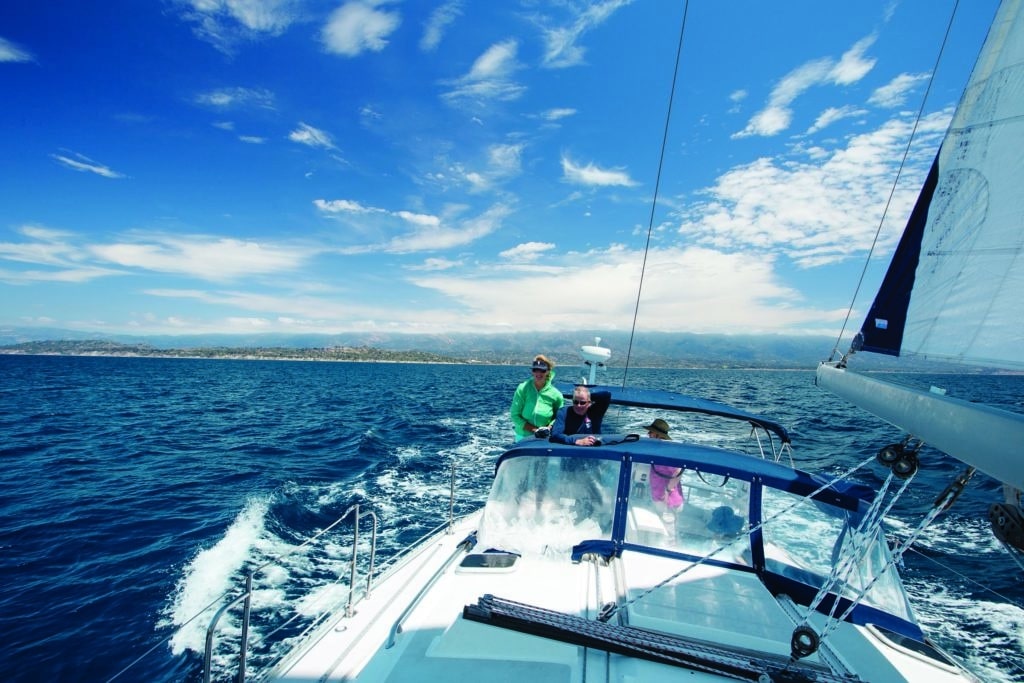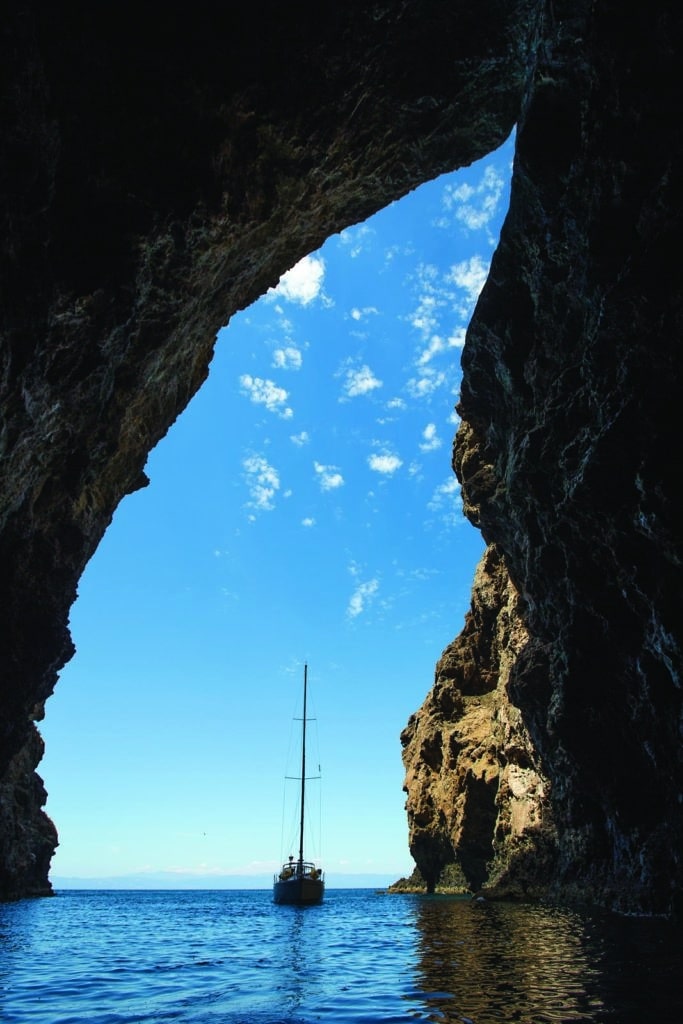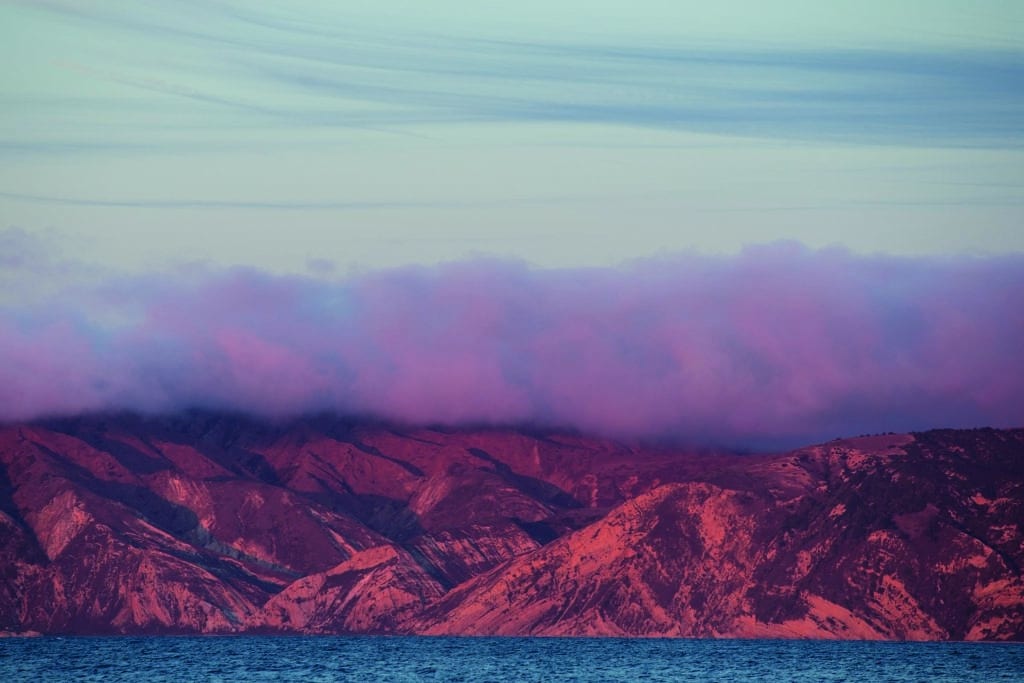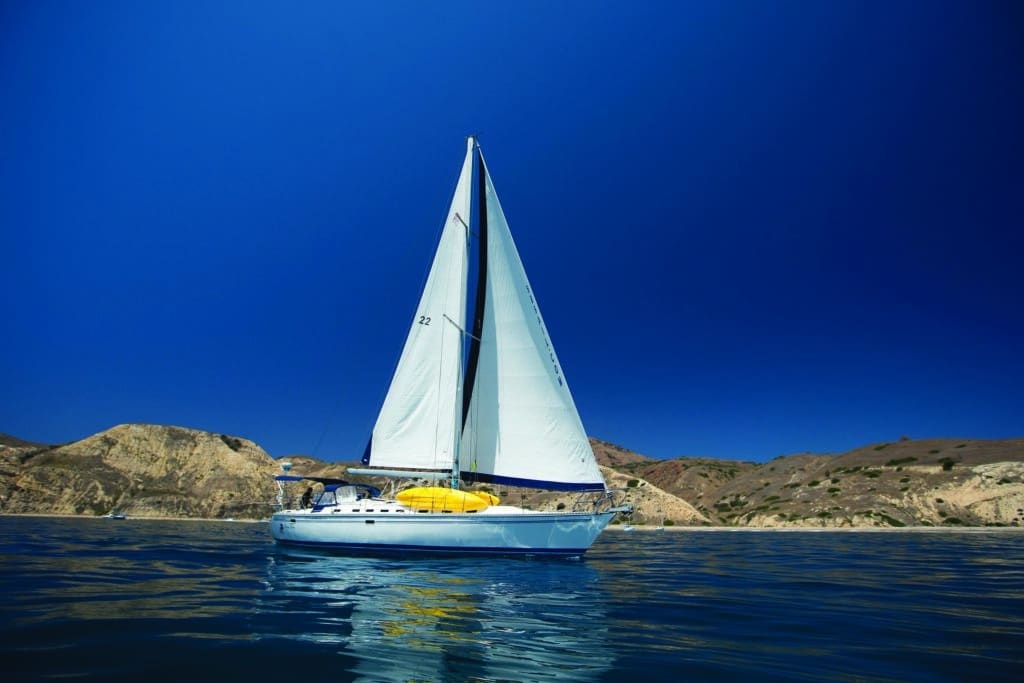
Seventy-five miles northwest of Los Angeles, the Pacific rushes up to the tidy Mediterranean-style city of Santa Barbara, at the foot of the Santa Ynez Mountains. Chic shops and galleries line State Street, tasting rooms and restaurants nestle in the Funk Zone, and rusty trawlers make room for luxury yachts in the marina, opposite timeworn Stearns Wharf.
Santa Barbara is one of the key jumping-off points for California’s Channel Islands, a chain that parallels the coastline. Embraced as both a national park and a marine sanctuary, the land and surrounding waters have been protected since 1980.
Twenty miles long and 6 miles at its widest point, Santa Cruz Island is rugged, verdant, and the jewel of the Channel Islands. Last summer it was our destination for a brief cruise with photographer Sharon Green and her partner, Brad Brown; friends Samantha and Steve Worzman; and Capt. Ken Miller, who, with more than 200 trips in local waters under his belt, acted as our guide. Our chariot was the 50-foot Catalina sloop Jenny Lane, chartered from Santa Barbara Sailing Center. SBSC, an independent charter company based in Santa Barbara Harbor, maintains a quiver of modern sailboats from 22 to 50 feet, plus kayaks and paddleboards for extracurricular fun.
We took off on a Monday morning, hoisting our main and unfurling the jib right out of the harbor, and set course for Santa Cruz Island about 20 miles to the south.
Two hours into the trip, the cockpit filled with squeals. Dolphins! We altered course to greet a pod of common dolphins, much smaller and more active than the “Flipper” or bottlenose variety. More than two dozen species of whales and dolphins are found in Santa Barbara Channel, along with many species of fish, marine mammals and birds. The convergence of cold northern currents and warmer waters from the south creates a veritable chowder of marine life.
As we approached the rocky shores of Santa Cruz Island, we spotted Painted Cave, a 160-foot-tall sea cave that is one of the island’s most famous features. With a nominal surge, conditions were ideal to explore, so we took the dinghy into the cathedral-like entrance painted with variegated rocks, algae and lichens. The deeper we went, the smaller the impressive cavern became. Dollops of condensation plopped and splattered around us in the dimming light, and random splashes and barks betrayed sea lions within.
The cave’s atmosphere seethed like the heavy breathing of a sleeping dragon, with the rising and falling sea forcing air through unseen natural vents. As we turned the corner we were pitched into total blackness, the shadowy haze disappearing astern. Utterly creeped out, we spun the dinghy and headed back toward the channel, where Capt. Ken hovered with the mothership.

The wind had picked up, so we quickly reunited and began anchorage shopping. There are more than two dozen spots around the island that are suitable for most any condition. We popped into several along the northern edge: Lady’s Harbor, which was overtaken by a family with a flotilla of kayaks and boards; Cueva Valdez, a beautiful but slightly exposed spot when windy; tiny Diablo anchorage; and Frys Harbor — a favorite, with its small pebbly beach, but already packed with several other cruisers. We continued to Pelican Bay, tucked in behind the high cliffs, and dropped the hook in the deep mud-and-sand bottom for the night.
The next day began too early. Like a pair of 5-year-olds on Christmas morning, Sharon and Brad were up at dawn, tapping and thumping on the cockpit floor and whispering too loudly, “When is everyone going to get up?”
Sharon eventually rowed the dinghy across the glassy pink water on a photographic mission. Brad made coffee, and, tantalized by the aroma, the rest of the crew roused and began a glorious day.
The western two-thirds of Santa Cruz Island is managed by the Nature Conservancy, which requires a landing permit that we’d obtained ahead of time. Right after breakfast, Ken shuttled us ashore to the southeast corner of the bay, where we offloaded onto a crusty ledge and scrambled up the faint remains of a stairway carved in the rock wall. We skirted the remnants of a resort that stood here nearly 100 years ago (popular with the Hollywood set during the Prohibition years) and found a small path that led us to a trailhead.
The 2-mile hike east toward Prisoners Harbor took us two hours, between detours to admire breathtaking vistas and take photos. The path led up and down through washes and ravines, twisted through swaying grasses, and skirted trees and boulders. It was lined with a variety of native plants and marked plentifully with the berry-peppered scat of island foxes, whose numbers have increased tremendously thanks to a breeding program undertaken by the Nature Conservancy and the park.
At the end of the trail we met a ranger, Jim, who lives on the island and maintains and manages the trails and historic buildings. Jim told us his favorite season is the summer: The fall months tend to have windless days (hard to imagine), and the spring more brisk conditions, though a spectacular display of wildflowers.
We were thankful Ken had offered to rendezvous with us at Prisoners Harbor. From an overlook we’d seen the wind dancing across the bight, fanning out her fingers to greet Jenny Lane. We radioed the captain and he dinghied over to pick us up from the landing at a large pier left over from the ranching days of the mid-1800s.

The wind was gusting in the mid-20s, so we ran briskly under jib alone at 7 knots. The northern shore looked uninviting with the surly sea state, but the instant we rounded San Pedro Point on the eastern end, the wind plummeted. In the lee of the island, we peeled off our jackets and basked in the sun.
Our next anchorage was at Yellowbanks, a calm, shallow inlet with a sandy bottom. As soon as we were set, we launched the kayaks. Samantha and Steve explored the shoreline while Sharon and Brad checked out the neighbors. Then, famished from our triathlon of hiking, sailing and kayaking, we enjoyed a dinner of fresh local produce with tri-tip and lobster tails on the grill. We watched the sky turn blue and pink and lavender, like a layer of cotton candy on the horizon.
I awoke Wednesday morning when the sun pierced the overhead hatch. The cockpit was adorned with birthday decorations for Sharon; there was a fun and festive day planned.
We observed the other boats in the anchorage pointed willy-nilly in the light air, but the swell and a dark blue perimeter of breeze just offshore foretold more serious conditions outside. With a gale warning in the forecast, we would stay tucked close to the island.
We departed Yellowbanks and hugged the southern shore of Santa Cruz as we meandered west. Along the way we saw a charter fishing boat and decided to slow down and try our luck. We drifted along, tossing our lures toward the kelp beds, landing a calico here and a little mackerel there, but mostly donating our bait to the bounty below. We spent so much time goofing off, we were forced to bypass a planned lunch stop at pretty Willows Anchorage and went directly to our haven for the night.
Alberts and Coches Prietos anchorages are separated by an imposing promontory — 432 feet of solid rock rising straight up from the water. We chose the slightly eastern cove, Alberts, where we anchored deep in, bow and stern, knowing that fishing boats might be joining us in the wee hours.
It was blazing hot in the glassy inlet, and once again we deployed our toys. We kayaked around the promontory to meet the wind and seas head on. Big waves charged at us. Sharon bobbed up and down at the bow of the kayak as if on a seesaw, and we rushed around the corner.
Once inside Coches, the bay was calm. Two other sailboats and a tall ship laden with boisterous teenagers were anchored there. We landed our kayaks and dinghy easily and stretched our legs on the sandy beach. On another visit, I’d hiked the short interior trail and seen foxes, but today was too hot for humans and canines alike. We contented ourselves in the delicious turquoise water. It was just as beautiful as any anchorage in the Caribbean or Sea of Cortez.

Later that night, after birthday dinner and cake, the squid boats arrived, circling the outer edge of the anchorage, their bright green-and-white glow looking like extra party lights for our celebration.
THUD!
THUMP! Flop, flop, flop, flop, flop, flop, flop! A clamor of thumping and shower of fish scales woke me at 0330. I discovered a 14-inch flying fish precariously straddling my hatch, attempting refuge in my cabin. Shoving him overboard, I pondered what monstrous beast had chased him so vigorously up onto the deck of the boat.
Outside, the sweet scent of sage wafted through the gully and mixed with the briny aroma of the seashore. Stars shone bright overhead against the black velvet sky. The Big Dipper nestled in the crook of the canyon; the Milky Way arced like a halo. Such is the magic of the Channel Islands. Although just off the coast of Los Angeles, it felt like we were worlds apart.
Later that morning Steve took inventory of our provisions and prepared a feast to sustain us for the ride home. With the wind expected to pipe up even more, we decided to return while we could. Racing against the impending gale, we steamed east in the lee of the island while readying the boat for the channel crossing. Here the water was slick, broken only by rafts of sea lions warming themselves in the California sun. But out there it was blowing and then some. We reefed the jib and main, poked our nose around the corner, and ventured out into Santa Barbara Channel.
Twenty-plus knots of breeze and big rolling seas blasted us from the northwest as we beat back to Santa Barbara. We bunched behind the dodger and enjoyed the exhilarating 24-mile sail home at a lively 7 knots, meanwhile planning our return trip for the spring.
Betsy Crowfoot is a West Coast sailor and writer whose home base is in Santa Barbara, California. Yachting photographer Sharon Green is the founder of the Ultimate Sailing Calendar. Her latest book, 30 Years of Ultimate Sailing, is available from her website, www.ultimatesailing.com.








